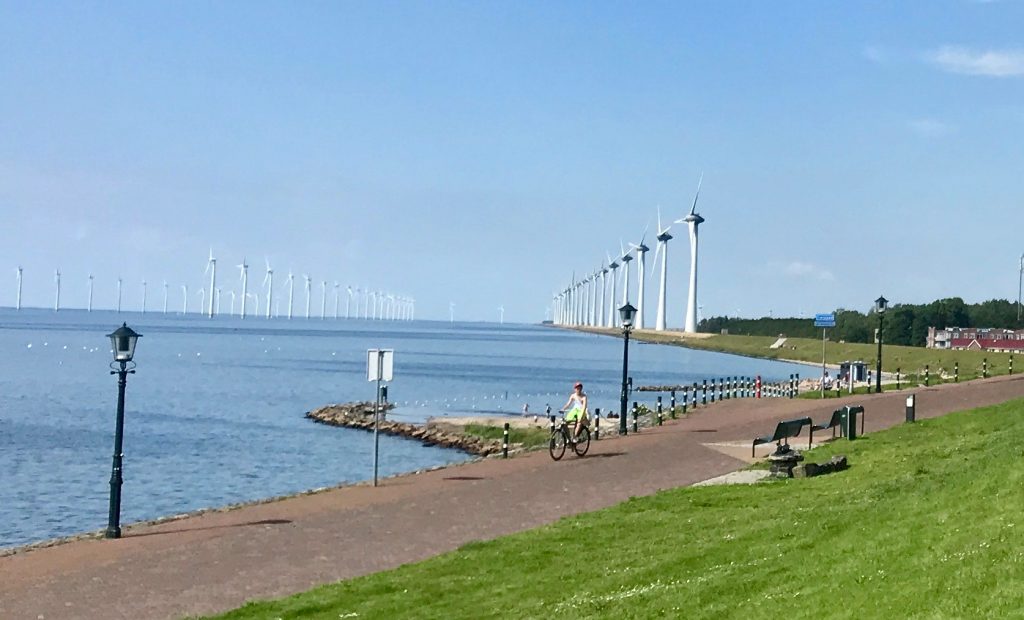By Evan Bright, Holland-Hope College Sustainability Institute
A world-class research organization known as Project Drawdown has crunched the numbers and ranked the most viable solutions to climate change based on the total atmospheric carbon dioxide reduction in their “plausible scenario” between 2020 and 2050.
Below are their top five solutions – and what can make the biggest difference might surprise you!
- Refrigeration Chemistry
Refrigeration and air conditioning units contain chemicals that enable chilling. Older, ozone-depleting chemicals (such as Freon) have been phased out, but were primarily replaced with hydroflourocarbons (HFCs) which spare the ozone layer but have 1,000 to 9,000 times more potential to warm the atmosphere than carbon dioxide. The newest and best replacements for refrigerants include propane and ammonium, which are both naturally occurring, making updated refrigeration technology an important step to fight climate change. - Onshore Wind Turbines
In many regions, wind energy is either competitive with or less expensive than coal energy, and it has no fuel cost nor pollution. Onshore wind farms use minimal land and still allow for alternate uses of much of the area, such as farming and grazing. On top of this, wind farms can typically be built in under a year, producing a quick return on investment. - Reduced Food Waste
One third of food that is produced does not make it to anyone’s fork. Production of food consumes many resources including water, energy, land, and labor, yet industry standards lead to much food being left to rot. Wasting of food is responsible for nearly 8 percent of global emissions. In lower income countries, the solution is to provide better infrastructure for storage and transportation, and in higher income countries, retailers and consumers need to change attitudes toward what is commonly acceptable.
After all, a misshapen carrot tastes the same as a “perfect” one. - Plant-Rich Diet
Shifting from a meat-heavy to a plant-rich diet leads to reduced emissions and a healthier body.
Plant-based options are becoming increasingly prominent, and we need to shift the collective mindset toward taking advantage of these alternatives more often. Just as important, we must end government subsidies benefiting the livestock industry, as they distort the true cost of meat and encourage the over-consumption of meat. - Tropical Forests
In recent decades, tropical forests have suffered destruction. What once covered 12 percent of the world’s landmass now only covers 5 percent. Tropical forests are responsible for holding a significant amount of carbon in the soil and vegetation. They also contribute to the health of every aspect of the environment and support natural cycles that we rely on for food, water, and life as a whole. We need to let forests regenerate, but at the very least need to stop destroying them to make room for livestock and agriculture.
These five strategies can make a huge impact on the amount of carbon released into our atmosphere. Solutions involve not only taking advantage of the newest technology but also rely on changing habits on an individual level.
We are at a pivotal point when it comes to controlling climate change, and increasing awareness of simple solutions is crucial. Project Drawdown has dug in far deeper beyond these top-ranked issues to demonstrate more solutions. To learn more, visit www.drawdown.org.
Evan Bright is an intern with the Holland-Hope College Sustainability Institute, a Holland-area native, and a Hope College math major graduated in December 2019.
MORE ONLINE
Project Drawdown
www.drawdown.org
Refrigeration
hollandbpw.com/en/energy-smart-program
hollandbpw.com/en/customer-service/residential/residential-rebates
energystar.gov/productfinder/product/certified-residential-refrigerators
Renewables
hollandbpw.com/en/14-category-en-gb/34-renewable-energy-rate
Food waste
www.ottawafood.org/resources/reduce-food-waste/
Plant Based Foods
www.facebook.com/VegLakeshore/
Tropical Rainforests
wwf.panda.org/our_work/forests/importance_forests/tropical_rainforest/
This Week’s Sustainability Framework Theme
Environmental Awareness/Action: Environmental education and integrating environmental practices into our planning will change negative outcomes of the past and improve our future.
ABOUT THIS SERIES
Living Sustainably is a collection of community voices sharing updates about local sustainability initiatives. It is presented by the Holland-Hope College Sustainability Institute, a joint project of Hope College, the City of Holland and Holland Board of Public Works. Go to www.hope.edu/sustainability-institute for more information.


